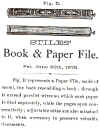|
| 1876 Centennial Exposition in Philadelphia |
Office Equipment &
Supplies
at the 1876 Centennial Exposition
The range of office supplies and equipment available in 1876 was limited. This page identifies office supplies and equipment that were displayed at the 1876 Centennial Exhibition in Philadelphia. While the exhibition included a number of cutting edge technologies that were not yet used to a significant extent (gelatin and stencil duplicators, typewriters, the telephone), many of the items were little different from ones available two decades or more earlier.
| Manufacturer/Description | Image | Source |
|
Paper, Ledgers and Blank Books |
||
| Many suppliers, including Marcus Ward & Co., London. Stationery. |  |
United States Centennial Commission, International Exhibition, 1876, Official Catalogue, Complete in One Volume, rev'd ed., 1876, Dept II, p. 152; trade card; Publishers" Weekly, July 1, 1876, p. 34. |
| Byron Weston, Dalton, MA. Ledger
paper. The display "consisted
of a pyramid, whose base was a ream of 'Leviathan' paper, five feet by
ten, and weighing 1,000 pounds, and other kinds in regular sizes up to the
top, which was a ream of cap, fourteen by seventeen inches."
According to an 1885 report, "His paper is used for county and state
records, and for all purposes where great strength and ability for
standing age are required." Byron Weston paper is still made,
and the maker states that for permanent records "Bryon Weston
Company Linen Record Ledger has been the national standard since
1863." The company was still advertising in 1904.
Other suppliers of paper for blank books and ledgers were Owen Paper Co., Housatonic, MA; L. L. Brown Paper Co., South Adams, MA; and Crane Bros., Westfield, MA. |
 |
J. S. Ingram, The Centennial Exposition, 1876, p. 237; Frank H. Norton, ed., Frank Leslie's Illustrated Historical Register of the United States Centennial Exposition, 1876, 1877, p. 116; Official Catalogue, Dept II, p. 131; Publishers" Weekly, July 1, 1876, p. 34. |
| Francis & Loutrel, New York, NY. Ledgers for banks, bank ledger's spring book patented in 1870, patent safety tinted check paper. Francis & Loutrel, which described themselves in 1862 as "manufacturing stationers and printers," was in business as a printer at least as early as 1853 and was still in business in 1883. | 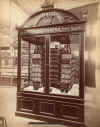 |
Free Library of Philadelphia, http://libwww.library.phila.gov; J.D. McCabe, The Illustrated History of the Centennial Exhibition, p. 854; Official Catalogue, Dept II, p. 131; Publishers' Weekly, July 1, 1876, p. 29. |
William F. Murphy's Sons, Philadelphia, PA.
Blank books and copying books.  This
company was in business from 1820 until at least 1920. This
company was in business from 1820 until at least 1920. |
 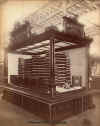 |
Free Library of Philadelphia; Norton, p. 124, Official Catalogue, Dept II, p. 133, and Dept V, p. 33; trade card, World's Fair Ephemeral and Graphic Materials Collection, Architecture Library, University of Maryland Libraries; Publishers" Weekly, July 1, 1876, p. 29. |
| Other suppliers of blank
books: R. C. Root, Anthony & Co., New York, NY (also ledgers for
banks), Koch, Sons & Co., New York,
NY (also bankers cases,
patent binders); Moss & Co., Philadelphia, PA; Wm. Mann, Philadelphia,
PA (also copying paper); J. B. Lippincott, Philadelphia, PA;
Boorum & Pease, New York, NY (also copying books); Bradley & Gilbert, Louisville,
KY; Short & Forman, Cleveland, OH; Gronthier-Dreyfuss, France.
Suppliers of items related to blank books: Walker, Evans & Cogswell, Charleston, S.C. (blanks, patent law-blank case); Boughman, Thomas & Co., Wilmington, DE (patent index for blank books and ledgers). |
. | Official Catalogue, Dept II, pp. 131-32; Publishers" Weekly, July 1, 1876, pp. 29, 36, 41. |
|
Small Filing Devices |
||
| Hart, Bliven & Mead Mfg. Co., New York, NY. Paper files, letter clips, paperweights. | . | Official Catalogue, Dept II, p. 130: Publishers" Weekly, July 1, 1876, p. 36. |
| Doubourget, France. Letter clips, inkstands. | . | Publishers" Weekly, July 1, 1876, p. 41. |
| Elizabeth W. Stiles, Vermont. Book and paper file, patented 1876. "A paper file, made of metal, the back resembling a book; through it extend parallel wires on which each paper is filed separately, while the pages open consecutively; adjustable sides are also attached to it, when necessary to preserve valuable documents." | Advertising leaflet, Hagley Museum and Library; Official Catalogue, Dept II, p. 130. | |
| William A. Amberg, New York, NY. File and binder. Amberg and a partner founded Cameron, Amberg & Co. in 1868. The company made its first letter files in 1875. Its Cabinet Letter Files were awarded a medal at the Centennial Exposition. Around 1895, the company name was changed to Amberg File & Index Co. |
Amberg file and binder, 1876 ad |
Official Catalogue, Dept II, p. 129. Illustrations to left are from Asher & Adams, Pictorial Album of American Industry 1876. |
| Koch, Sons & Co., New York, NY. Patent binders and bankers cases. | . | Official Catalogue, Dept II, p. 131. |
| Eldridge J. Smith, Philadelphia, PA. Bill holder. | . | Official Catalogue, Dept II, p. 130. |
| E. W. Woodruff, Washington, DC. File holders for business and official papers, patented in 1868. The US Patent Office spent $682.50 to purchase Woodruff file holders in 1879 (Annual Report of the Commissioner of Patents. See table at bottom of the present page.). Recently a very large number of Woodruff file holders were sold by the National Archives. | [Illustration to be added] | Official Catalogue, Dept II, p. 130; Publishers' Weekly, 1876, p. 565. |
| Paperweights from Centennial Exhibition, 1876 |
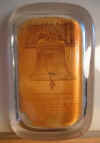 Liberty Bell Memorial Hall |
Artifacts |
| Writing Implements and Accessories: Lead Pencils | ||
| Eagle Pencil Co., New York, NY. Lead and mechanical pencils, leads, copying brush handles. Eagle, which was founded in 1856, subsequently advertised that its pencils received an award at the exhibition. |
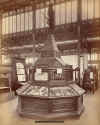
|
Free Library of Philadelphia. Label on box of Eagle pencils marketed after 1876; Official Catalogue, Dept II, p. 130; Publishers" Weekly, July 1, 1876, p. 34. |
| American Lead Pencil Co., New York, NY. Lead pencils. This company established a pencil manufacturing factory in New York, NY, and advertised pencils in 1865. | See Publishers" Weekly, July 1, 1876, p. 32f for image of showcase. | Historical Society of Pennsylvania, Jane Campbell Scrapbooks, v. 10, p. 96, 103, 1876; Official Catalogue, Dept II, p. 130; Publishers" Weekly, July 1, 1876, p. 33 |
| Dixon Crucible Co., Jersey City, NJ. Graphite pencils. | . | Official Catalogue, Dept II, p. 129; Publishers" Weekly, July 1, 1876, p. 32. |
| Eberhard Faber, New York, NY. Lead pencils, penholders, rubber bands, rulers, copying brush handles. | . | Official Catalogue, Dept II, p. 130; Publishers" Weekly, July 1, 1876, p. 33. |
| A. W. Faber & Co., Germany. Lead pencils. | . | Publishers" Weekly, July 1, 1876, p. 42. |
| Schwanhaüsser, Nuremberg, Germany. Lead pencils, copying pencils. | . | Publishers" Weekly, July 1, 1876, p. 42. |
| Writing Implements and Accessories: Pencil Sharpeners | ||
| W. A. Young, Jacksonville, FL. | . | Official Catalogue, Dept II, p. 130. |
| Writing Implements and Accessories: Pens, Penholders, Mechanical Pencils, | ||
| Henry Charles Stephens, London, England. Quill pens. | . | Official Catalogue, Dept II, p. 152. |
| Leroy W. Fairchild & Co., New York, NY. Gold pens, pen and pencil cases. Fairchild was established in 1843. |
 |
Free Library of Philadelphia; Official Catalogue, Dept II, p. 130; trade card; Publishers" Weekly, July 1, 1876, p. 31. |
| Aiken, Lambert & Co., New York, NY. The display case contained "a large and varied assortment of eighteen carat gold pen and pencil-cases finished in Roman, enamel, carving and red gold....pens of all sizes; Leviathan, Mammoth, Oblique, Spencerian, Ruling, Ladies', Red Ink Pens, Gold Barrel Pens in pearl and other holders." The company was purchased by L. E. Waterman, another pen company, in the 1930s. |
|
Ingram, pp. 226-29; Norton, pp. 108-10; Official Catalogue, Dept II, p. 130; Publishers" Weekly, July 1, 1876, p. 31. |
| R. Esterbrook & Co. (a.k.a. Esterbrook Steel Pen Co.), Camden, NJ, and New York, NY. Steel pens. This company was founded in 1851 and, in 1860, it began production of steel pens at the United States Steel-Pen Works, Camden, NJ. Although unsuccessful attempts to manufacture steel pens in the US had been made earlier, this was the first company to manufacture steel pens successfully in the US. In 1866, the company was renamed the Esterbrook Steel-Pen Manufacturing Co. In 1867, Richard Esterbrook was president of the company, which purchased a pen holder factory at Worcester, MA. |
|
McCabe, p. 853; trade card to left, which has an illustration of Centennial Exhibition on other side; Official Catalogue, Dept II, p. 130; Publishers" Weekly, July 1, 1876, p. 36. |
| John Holland, Cincinnati, OH. Gold pens, pencil cases, penholders. | . | Ad flyer, Philadelphia Centennial Exhibition Collection, American Antiquarian Society; Official Catalogue, Dept II, p. 130: Publishers" Weekly, July 1, 1876, p. 31. |
| Mabie, Todd & Bard, New York, NY. "Manufacturers of gold pens and holders." Also pencil cases. Mabie, Todd & Co. was established in 1860; the company became Mabie, Todd & Bard in 1873. | . | Ad flyer, American Antiquarian Society; Official Catalogue, Dept II, p. 130. |
| Additional suppliers of gold pens, penholders, pencil cases, and pencils: E. S. Johnson, New York, NY; John Foley, New York, NY; James Morton, New York, NY. | . | Official Catalogue, Dept II, p. 130-31:Publishers" Weekly, July 1, 1876, p. 31. |
| Spencerian Steel Pen Co. Spencerian steel pens. The Spencerian Steel Pen Co. was founded in the US in 1858. It sold pens made in the UK. | . | Trade card, University of Maryland. |
| Hinks, Wells & Co., Buckingham Steel Pen Works, Birmingham, England. Steel pens, penholders | . | Official Catalogue, Dept II, p. 152. |
| Blanzy-Poure et Cie, France. Steel pens, pencholders. | . | Publishers" Weekly, July 1, 1876, p. 41. |
| D. M. Somers, Brooklyn, NY. Penholders. | . | Official Catalogue, Dept II, p. 130: Publishers" Weekly, July 1, 1876, p. 31. |
| F. Soenneken, Remscheid, Germany. "The Round Writing" [pen]. | . | Ad flyer, American Antiquarian Society; Official Catalogue, Dept II, p. 348. |
| Geo. F. Hawkes, New York, NY. Gold pens, penholders, pencil cases, patent combination fountain pen, penholder, and inkstand. | . | Advertising leaflet, University of Maryland Libraries; ad flyer, American Antiquarian Society; Official Catalogue, Dept II, p. 130; Publishers" Weekly, July 1, 1876, p. 31. |
| Writing Implements and Accessories: Writing Inks | ||
| Carter, Dinsmore & Co., Boston, MA. Writing and copying inks. Lombard's and Carter's inks. Carter's inks were produced for over 100 years, beginning in 1858. The name of the company that produced Carter's inks changed several times, and included William Carter Co. (1858-60), Carter & Bro. (1860), William Carter & Bros. (1861), Carter Bros. & Co. (1867-68), Carter, Dinsmore & Co. (1872-1901), and Carter's Ink Co. (beginning in 1901). For more information on Carter inks, click here. |
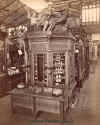
|
Free Library of Philadelphia; advertising leaflet, University of Maryland; Official Catalog, Dept II, p. 104; Publishers" Weekly, July 1, 1876, p. 32. |
| John Raynald, Philadelphia, PA. Jet Black French Writing Ink. Raynald was in business by 1860. | . | Ad flyer, American Antiquarian Society; Official Catalogue, Dept II, p. 104: Publishers" Weekly, July 1, 1876, p. 32. |
| Lockwood, Brooks & Co., Boston, MA. Writing ink. This company was active as a publisher during 1875-83. | . | McCabe, p. 847; ad flyer, American Antiquarian Society; Official Catalogue, Dept II, p. 104. |
| Maynard & Noyes, Boston, MA. Permanent Black Writing Inks, copying inks. The company was established in 1816 and was selling writing inks by 1820. It advertised inks in the late 1860s. | . | McCabe, p. 847; ad flyer, American Antiquarian Society; Official Catalogue, Dept II, p. 105: Publishers" Weekly, July 1, 1876, p. 32. |
| Thaddeus Davids & Co., New York, NY. Writing ink, ink powder. This company was founded in 1824. |
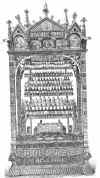
|
Trade card; Norton, p. 151; Official Catalogue, Dept II, p. 104; Publishers" Weekly, July 1, 1876, pp. 31-32. |
| Joseph E. Hover & Co., Philadelphia, PA. Ink. | . | Official Catalogue, Dept II, p. 104; Ad, American Antiquarian Society: Publishers" Weekly, July 1, 1876, p. 32. |
| Jos. Fromherz, Cincinnati, OH. Writing ink. | . | Official Catalogue, Dept II, p. 104; Ad, American Antiquarian Society: Publishers" Weekly, July 1, 1876, p. 32. |
| Francis & Loutrel, New York, NY. Copyable printing ink patented in 1872, for use with copying presses. | . | McCabe, p. 847; Official Catalogue, Dept I-III, p. 105 |
| Henry Charles Stephens, London, England. Stephens' Writing Fluids and Copying Inks. Henry Charles Stephens's father, Henry Stephens, invented a Blue-Black Writing Fluid in 1832, and the family company was in business in England by 1834. | . | Advertising leaflet, University of Maryland; ad flyer, American Antiquarian Society; Official Catalogue, Dept II, p. 152. |
| Other suppliers of writing inks: Toiray-Maurin, France (see illustrations to right); Reisinger Mfg. Co., Harrisburg, PA; Geo. A. Moss, New York, NY; Continental Ink Mfg Co., Philadelphia, PA; Joseph S. C. Rowland, Philadelphia, PA; Larenaudieu, France (Guyot inks); L. Antoine Fils, France (also copying inks and mucilage). |
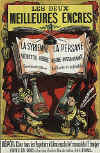 Adrien Maurin Inks (both trade cards) |
Official Catalogue, Dept II, pp. 104-105; Publishers" Weekly, July 1, 1876, p. 41. |
| Jeff. O. Bentley, Philadelphia, PA. Bentley's Jet Black Indelible Ink. | . | Advertising leaflet, University of Maryland; Official Catalogue, Dept I-III, p. 126. |
| Writing Implements and Accessories: Inkstands, Blotters, Blotting Sand | ||
| Nicholas Muller's Sons, New York, NY. Bronze inkstands. |
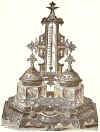
|
McCabe, p. 861; Official Catalogue, Dept II, p. 130; Publishers' Weekly, July 1, 1876, p. 32; Publishers' Weekly, 1876, p. 480. |
| Elizabeth W. Stiles, Philadelphia, PA. Revolving inkstand. One application was as an attachment to the combination desk and bookcase by the same manufacturer (see below). "A pivoted ink well, which always retains the ink without spilling, owing to its rotary motion while the folding leaf of the desk is being raised or lowered. It is also adapted for marine purposes." |
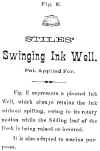
|
Official Catalogue, Dept II, p. 130; advertising leaflet, Hagley Museum and Library. |
| Brower Brothers, New York, NY. Inkstands including patented Euroid brand inkstand, paper weights, sponge cups, Adams permanent letter files. | For an illustration of the Euroid inkstand, see Publishers' Weekly, July 1, 1876, p. 103.. | Trade card and advertising leaflet, University of Maryland; Official Catalogue, Dept II, p. 130: Ad, American Antiquarian Society: Publishers" Weekly, July 1, 1876, pp. 32, 103. |
| Wm. D. Bennage, Jr., Philadelphia, PA. Memorial inkstand. |
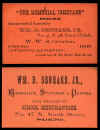
|
Business card. |
| Hart, Bliven & Mead Mfg. Co., New York, NY. Inkstands. | . | Official Catalogue, Dept II, p. 130: Publishers" Weekly, July 1, 1876, p. 36. |
| Henry Charles Stephens, London, England. Inkstands. | . | Official Catalogue, Dept II, p. 152. |
| Joseph Parker, Son & Co., New Haven, CT. Blotting paper. | . | Business card, American Antiquarian Society; Official Catalogue, Dept II, p. 131; Publishers" Weekly, July 1, 1876, p. 37. |
| Juan de Quintana, Las Palmas, Canary Islands. Blotting sand. | . | Official Catalogue, Dept II, p. 277. |
| Thaddeus Davids & Co., New York, NY. Pounce powder. | Publishers" Weekly, July 1, 1876, pp. 31-32. | |
| Mucilage and Paste | ||
| Lockwood, Brooks & Co., Boston, MA. Mucilage. | . | McCabe, p. 801; ad flyer, American Antiquarian Society; Official Catalogue, Dept II, p. 104. |
| Carter, Dinsmore & Co., Boston, MA. For further information on this company, see above in the section on Inks. |  |
Official Catalogue, Dept II, p. 104; trade card. |
| John Nathan & Son, New York, NY. Mucilage. | Image of mucilage bottle at Publishers" Weekly, July 1, 1876, p. 96. | This company apparently did not participate in the exhibition, but it advertised while the exhibition was taking place. |
| Charles J. Cohen, Philadelphia, PA. Mucilage, agate stylus, copying paper, leads. | . | Publishers" Weekly, July 1, 1876, p. 36. |
| Other suppliers of mucilage: Hover; Thaddeus Davids; John Raynald; Continental Mfg.; Jos. Fromherz, Cincinnati, OH; Continental Ink Mfg Co., Philadelphia, PA | . | Official Catalogue, Dept II, p. 104; Publishers" Weekly, July 1, 1876, p. 32. |
| John S. Chase, Union Paste & Sizing Co., New York, NY. Eureka paste for office, library, and household. | . | Official Catalogue, Dept II, p. 130. |
| Paper Fasteners | ||
| George W. McGill, New York, NY. "McGill's patent fasteners for binding papers of all descriptions; McGill's patent letter clips, punches, presses, copying press." McGill was a prolific inventor of brass paper fasteners and paper fastening devices from the mid-1860s through the early 1890s. In 1866 he was awarded a patent for a small bendable brass paper fastener, and in 1867 he was awarded a patent for a press designed to insert these fasteners into papers. He was awarded a medal at the Centennial Exhibition. | . Ad from Asher & Adams' Pictorial Album of American Industry 1876. |
Official Catalogue, Dept II, p. 129; Publishers" Weekly, July 1, 1876, p. 36. |
| Hymen L. Lipman (1817-93), Philadelphia, PA. Eyelet machines, eyelets. Hymen L. Lipman was a stationer before 1850. He was awarded a patent for an eyelet press in 1854 and advertised eyelet presses until his death in 1893. Lipman eyelet machines were sold until at least 1899. | 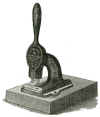 This Lipman eyelet press was advertised at least as early at 1878. |
Official Catalogue, Dept II, p. 130; Publishers" Weekly, July 1, 1876, p. 36. |
|
Mailing Equipment |
||
Fairbanks
and Ewing, Philadelphia, PA, and E. & T. Fairbanks, St. Johnsbury, VT. Fairbanks Standard
Scales, counter scales of all descriptions. The company was
established in 1830.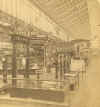 Exhibits of Howe Scales and Fairbanks Scales, stereoview, James
Cremer, 1876
Exhibits of Howe Scales and Fairbanks Scales, stereoview, James
Cremer, 1876 Howe scales won awards as early as 1857. |
Trade cards; brochure, American Antiquarian Society; Official Catalogue, Dept V, p. 48. | |
| Elizabeth C. Jay, New York, NY. Postage stamp moistener. | . | Official Catalogue, Dept. V, p. 90. |
| Thaddeus Davids & Co., New York, NY. Sealing wax. | . | Publishers" Weekly, July 1, 1876, pp. 31-32. |
| Dennison & Co., Boston, MA, and New York, NY. Sealing wax. In 1868, Dennison & Co. obtained a patent for and advertised "Patent Direction Labels and Shipping Cards" (that is, shipping labels). | . | Publishers" Weekly, July 1, 1876, p. 36. |
|
Seal Presses, Ribbon Dating Stamps, Rubber Stamps |
||
| W. A. Bunting, Pittsburgh, PA. Notarial seals, ribbon stamps, rubber stamps, wax seals, name plates, name stamps, inks. | . | Trade card, Warshaw Collection, National Museum of American History, Smithsonian Institution |
| John Goldsborough, Philadelphia, PA. Ribbon machine and hand stamps (with rubber or lead type), perforating and canceling stamps. | . | Official Catalogue, Dept II, p. 130; Publishers' Weekly, July 1, 1876, p. 31. |
| G. K. Cooke & Co., New York, NY. Patent self-inking hand stamps, seal presses, safety check protectors. | Self-inking hand stamp is illustrated at Publishers' Weekly, July 1, 1876, p. 107. | Official Catalogue, Dept II, p. 130; Publishers' Weekly, July 1, 1876, p. 31. |
| T. S. Buck & Co., Davenport, IA. Rubber dating stamps, hand stamps. This company was established as The Rubber Stamp Manufactory in 1867. | . | Official Catalogue, Dept II, p. 130; Publishers' Weekly, July 1, 1876, p. 31. |
| Walker, Tucker & Co., Philadelphia, PA. Rubber hand stamps. | . | Official Catalogue, Dept II, p. 130; Publishers' Weekly, July 1, 1876, p. 31. |
| D. A. Edsall, New York, NY. Rubber hand stamps | . | Official Catalogue, Dept II, p. 131; Publishers' Weekly, July 1, 1876, p. 31. |
| William Croft & Co., New York, NY. Rubber stamps | . | Publishers' Weekly, July 1, 1876, p. 36. |
| Wm. J. Youngs & Sons, Philadelphia, PA. Hand stamps. | . | Official Catalogue, Dept II, p. 130. |
| William Thompson Frohock, Philadelphia, PA. Wooden name stamp and other novelties. The name stamp, which is illustrated at the lower right of the image to the left, was patented in 1871 and can be seen in the Early Office Museum's exhibit by clicking here and scrolling down. |  |
Official Catalog, Annex, p. 380; advertising cover. |
|
Copying Equipment: Copying Presses |
||
| Boomer & Boschert Press Co., Syracuse, NY. Copying presses | . | Official Catalogue, Dept V, p. 33. |
| Hoffman & Hoyt, New York, NY. Lever copying presses | Illustrated in Publishers" Weekly, July 1, 1876, at pp. 37, 96. | Official Catalogue, Dept V, p. 33; Publishers' Weekly, July 1, 1876, pp. 37, 96. |
| Moonert & Roschert Press Co., Syracuse, NY. Copying presses | . | Publishers' Weekly, July 1, 1876, p. 37. |
|
Copying Equipment: Manifold Writers |
||
| Francis & Loutrel, New York, NY. "Manifold writers, by which letters and copies are written at the same time" with the use of carbon paper. | . | Official Catalogue, Dept II, p. 131. |
|
Copying Equipment: Stencil and Hektograph Duplicators |
||
| Thomas A. Edison,
Newark, N.J. Electric pen and duplicating press. This won a medal.
The pen and press were advertised at $35 in 1876 by Charles Batchelor, New York, NY. |
 |
Advertising leaflet and pamphlet, University of Maryland; Official Catalogue, Dept III, p. 331; Publishers' Weekly, July 1, 1876, p. 109 (illustrated advertisement). |
| J. R. Holcomb & Co., Medina County, OH. Hektograph gelatin copier. | Broadside distributed at Centennial Exposition. | |
|
Small Printing Presses |
||
| W. A. Kelsey & Co., Meriden, CT. Portable printing presses for office use. Excelsior printing presses from $3. Kelsey began producing small presses in 1872. The Briar Press website (briarpress.org) has photographs and information on early Kelsey presses: Click here: 1, 2, 3, 4. |  |
Broadside distributed at Centennial Exposition. Trade card, Warshaw Collection. Official Catalogue, Dept V, p. 32. |
| H. Hoover & Co., Philadelphia, PA. "$3 Best Press," a small press similar in appearance to the Kelsey press illustrated above. | . | Business card, American Antiquarian Society; Official Catalogue, Dept V, p. 32 |
| Benjamin O. Woods & Co., Boston, MA, a.k.a. the Novelty Printing Press Co. Amateur printing presses. William Tuttle and Benjamin O. Woods produced small presses in Boston by 1857. The company was acquired by Kelsey in 1887. The Briar Press website (briarpress.org) has photographs of and information on early Novelty presses: Click here: 1, 2. | . | Trade card; Official Catalogue, Dept V, p. 32. |
| J. W. Daughaday & Co., Philadelphia, PA. Model Printing Press |  |
Trade card; Official Catalogue, Dept V, p. 32. |
| Communications Equipment: Electric Bells and Annuciators | ||
| Patrick & Carter, Philadelphia, PA. Hotel annunciators, electric bells. | . | Official Catalogue, Dept III, p. 331. |
| Thos. E. Cornish, Philadelphia, PA. Electric annunciators, bell calls. Cornish subsequently founded the first telephone exchange in Philadelphia. | . | Official Catalogue, Dept III, p. 331 |
| Communications Equipment: Telephone | ||
| Alexander Graham Bell. Boston, MA. Described by Sir William Thomson (Lord Kelvin) as "the most wonderful thing he has seen in America." However, according to a description of the exhibition written 90 years later, "One new invention which interested hardly anybody was Alexander Graham Bell's telephone. It attracted less notice than the packages of magic tricks on sale nearby." (Dee Brown, The Year of the Century: 1876, 1966, p. 133.) The top photo to the right shows Bell speaking into a telephone and the bottom shows the telephone receiver, both from the Centennial Exhibition. |   |
H. M. Boettinger, The Telephone Book, 1977, pp. 81-87; Official Catalogue, Dept III, p. 332. |
| Communications Equipment: Telegraph | ||
| Thomas A. Edison, Newark, NJ, and Atlantic & Pacific Telegraph Co., Philadelphia, PA. Edison's American Automatic Telegraph and duplex telegraph; Roman letter, etheric, domestic, and quadraplex telegraph. Edison's Automatic Telegraph was completed in 1872 and was recommended by Lord Kelvin for an award at the 1876 Centennial Exposition. |  Edison's Automatic Telegraph |
Lawrence A. Frost, The Thomas A. Edison Album, 1969, p. 45; Official Catalogue, Dept III, p. 331, and Dept V, p. 147; McCabe, p. 859. |
| Patrick & Carter, Philadelphia, PA. Learner's telegraph, telegraph sounders. |  Learner's Telegraph |
Ingram, p. 294; Official Catalogue, Dept III, p. 331. |
| Welch & Andres, Boston, MA. Magneto-printing and dial telegraph instruments. In the case of the magneto-printing telegraph, "As the words are spelled out on the keys they are printed on a strip of paper." |  Magneto-printing telegraph |
Ingram, pp. 292-95: Official Catalogue, Dept III, p. 331. |
| Western Union Telegraph Co., New York, NY. Quadruplex electric telegraph and Phelps printing telegraph. |  |
Scientific American,
1877. McCabe, p. 859; Official Catalogue, Dept III, p. 332. |
| Gray & Barton, Western Electric Manufacturing (or Telegraph) Co., Chicago, IL. Gray's automatic printer (or printing telegraph). | . | Ingram, p. 295; Official Catalogue, Dept III, p. 331, and Dept V, p. 147. |
| Elisha Gray, Chicago, IL. Electro-harmonic telegraph, including apparatus for transmitting eight or more messages simultaneously. | . | Official Catalogue, Dept III, p. 331, and Dept V, p. 147. |
| William J. Philips, Philadelphia, PA. Printing telegraph instrument, combining the bell, dial, and printing telegraph in one instrument. | . | Official Catalogue, Dept III, p. 331, and Dept V, p. 147. |
| Philadelphia, Reading & Pottsville Telegraph Co., Philadelphia, PA. Duplex and Morse telegraph. | . | Official Catalogue, Dept V, p. 147. |
| Launert & Decker, Cleveland, OH. Alphabetical telegraph instruments. | . | Official Catalogue, Dept III, p. 331. |
| Lockwood, Brooks & Co., Boston, MA. Computing telegraph. | . | Official Catalogue, Dept III, p. 331. |
| William B. Watkins, New York, NY. Duplex telegraph. | . | Official Catalogue, Dept III, p. 332. |
| Alexander Graham Bell, Boston, MA. Electro-harmonic telegraph. | . | Official Catalogue, Dept III, p. 332. |
| Samuel S. White, Philadelphia, PA. Electro-harmonic telegraph. | . | Official Catalogue, Dept III, p. 331. |
| Standard Laundry Machinery Co., Boston, MA. Telegraph copying machine. | Official Catalogue, Dept V, p. 33. | |
| Writing Machines: Typographic Machine | ||
| Dr. A. Shiland, West Troy, NY. American Typographic machine. Patented 1871. |  |
Ingram, pp. 298-99. |
| Writing Machines: Typewriters | ||
| Malling Hansen, Denmark, Writing Ball. The Official Catalogue for the Centennial Exhibition does not say that the Hansen Writing Ball typewriter was exhibited at the Centennial Exhibition. However, a recreation of the exhibition at the Smithsonian in the early 1990s included a Writing Ball, so it may have been exhibited. (ETCetera, No. 19, June 1992) | . | . |
| M. Alissoff, St. Petersburg, Russia. Type-writer, a.k.a., The Mechanical Printer. "M. Alisoff, a Russian inventor, exhibited an admirable type-writer, which excels all contrivances of its kind, in the variety of characters that can be used and in the neatness of the impression, and the mechanical adjustment, but does not admit of the rapidity of the American machines exhibited." Adler states of Alissoff: "A Russian inventor by this name designed and built a type wheel machine, patented in France in 1872.... An example was exhibited at the Philadelphia Exhibit in 1876 where it competed with the recently introduced Sholes and Glidden model made by Remington. It won this particular competition, receiving eloquent commendation in the official reports for the beauty of its construction and design while the American machine, which was crude by comparison, was not even mentioned. History can make judges look foolish and one can only assume that they were swayed by the superior quality of the construction since the details of the design were somewhat clumsy and anachronistic. The letters of the alphabet, upper and lower case, were displayed on a circular index and selected by means of a handle attached to a type wheel." | . | Ad, American Antiquarian Society; Official Catalogue, Dept V, p. 69; Michael Adler, Antique Typewriters, 1997, p. 85; photograph of Russian exhibit, Free Library of Philadelphia. |
| John Pratt, Centre, AL. Typewriter. The Pratt typewriter model in the photo to the right, which is from Mares (1909, p. 35), may or may not be the same model that was displayed at the Centennial Exhibition. | 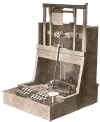 |
Official Catalogue, Dept. V, p. 33. For a discussions of Pratt's typewriters, see G. C. Mares, The History of the Typewriter, 1909, pp. 34-41, and Scientific American, July 6, 1867. |
| E. Remington & Sons, Ilion, NY. Sholes and Glidden typewriter. This may have appeared in the exhibit of John W. Bain, Philadelphia, PA, who offered a typewriter described as follows: "Typewriter: supercedes the pen, faster, manifolds, keys like a piano. $125." At the exhibition, "For fifty cents, one could have a letter written to a friend back home on the new typewriting machine." (Dee Brown, The Year of the Century: 1876, 1966, p. 132.) One of these letters is pictured to the right. | 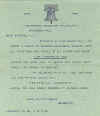  |
Form letter and envelop addressed on a Sholes & Glidden typewriter at the Centennial Exposition, Oct. 16, 1876. Official Catalogue, Dept V, p. 33. |
| Calculating Machines | ||
George Bernard Grant, Boston, MA. Calculating machine. According to a Tribune exhibit catalog, the
Grant difference engine was used to construct large mathematical tables,
such as tables of logarithms, and prepared a mould stamped in wax from
which an  electrotype printing plate was made. The machine, which was
presented to the Univ. of PA, reportedly cost $10,000. According to IBM, "Grant (1849-1917)
invented his first calculator in 1871 and exhibited it at the 1876
Centennial Exhibition. It was eight feet long and five feet high, weighed
2,000 pounds, and had 15,000 parts." electrotype printing plate was made. The machine, which was
presented to the Univ. of PA, reportedly cost $10,000. According to IBM, "Grant (1849-1917)
invented his first calculator in 1871 and exhibited it at the 1876
Centennial Exhibition. It was eight feet long and five feet high, weighed
2,000 pounds, and had 15,000 parts." Grant also displayed a small calculating machine that performed multiplication and division. It was made from 400 parts at a cost of $100 and was about 1' long and 6" high. A later calculating machine invented by Grant is illustrated in Manufacturer and Builder, Sept. 1894, pp. 195-96, and on the IBM web site. To see our discussion of Grant's smaller calculating machines, click here and scoll down. |
  |
Free Library of Philadelphia; Phillip T. Sandhurst, The Great Centennial Exposition, 1876; "Guide to the Centennial Exhibition," Tribune, New York, Extra No. 35, 1876, Warshaw Collection. See also Official Catalogue, Dept V, p. 33; IBM web site. |
| Desks and Cabinets | ||
| Elizabeth W. Stiles, Vermont. Combination desk and book-case, patented in 1875. Stiles won a first prize for this item. When folded, the item was 18" deep, 6' wide, and 7' high. When unfolded, there were tilting tables, inkpots, closets, drawers, racks, 26 pigeon holes, and a wastebasket. The items seems to have been designed for homes rather than offices. |  |
Ingram, pp. 330-34; Official Catalogue, Dept II, p. 110; ad, University of Maryland. |
| Wooton Desk Co., Indianapolis, IN. "Patent Cabinet Secretaries and Rotary Office Desks." For additional information and illustrations, please go to our exhibit on Desks. | 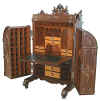
|
Brochure, American Antiquarian Society; Official Catalogue, Dept II, p. 111. Photograph courtesy of Antiquarian Traders, Beverly Hills, CA |
| B. Schafer, Wood County, WV. Patent office desks. | . | Official Catalogue, Dept V, p. 128. |
| A. Cutler & Son, Buffalo, NY. Business desks. | . | Official Catalogue, Dept II, p. 110. |
| Bahse & Haendel, Chemnitz, Saxony. "Universal writing desk for use in school, house and office to be regulated by mechanism so as to suit persons of all sizes." | . | Ad flyer, American Antiquarian Society; Official Catalogue, Dept II, p. 202. |
| D. L. Ransom & Co., Buffalo, NY. Patent adjustable desks (cylinder, tambour, and slant-top) and business cabinets for private and general offices. An 1876 advertisement offers variations of the desk pictured to the right for sitting, for standing, and for which the writing surface could be adjusted to any height for sitting or standing. The illustrations to the right show Desk No. 1 for standing, both open and closed. These are the earliest American-made office desks that we are aware of with pull-down tambour covers. For illustrations that show Desk No. 1 for sitting, please go to our exhibit on Desks. |  Open  Closed |
1876 Broadside in Early Office Museum Archives; ad, American Antiquarian Society; Official Catalogue, p. 111 and Dept II, p. 202. |
| A. H. Andrews & Co., Chicago, IL. Office and bank furniture, cylinder and other office desks; . | . | Official Catalogue, Dept II, p. 112; Publishers" Weekly, July 1, 1876, p. 35. |
| William. A. Amberg, New York, NY. File. Cameron Amberg & Co., the predecessor of the Amberg File and Index Co., was established in 1868 and made its first Cabinet Letter Files in 1875. Its Cabinet Letter Files were awarded a medal at the exhibition. They were exhibited by W. F. Adams, New York, NY, general agent. In a contemporary advertisement, Adams offered Amberg's Cabinet Letter File with 6 to 40 flat file drawers, with prices from $25 to $164. |
 Amberg Cabinet Letter Files, 1876 ad |
Official Catalogue, Dept II, p. 129; Cameron, Amberg & Co. advertising; Publishers" Weekly, July 1, 1876, pp. 37, 97. |
| Brower Brothers, New York, NY. Copy press stand with water bowl attached. | . | Trade card and advertising leaflet, University of Maryland; Official Catalogue, Dept II, p. 130: Ad, American Antiquarian Society: Publishers" Weekly, July 1, 1876, p. 32. |
| Matthew de Bock, Boston, MA. Cabinet. | . | Official Catalogue, Dept II, p. 112; James Wallen, Things That Live Forever: Being the Story of Office Equipment from the Dawn of Thought to the Age of Art Metal, c. 1921. |
| Safes | ||
| Herring & Co., Boston, MA, and New York, NY. Patent Champion Fire-Proof Safes; also locks. Silas C. Herring began producing fire proof Salamander safes in New York City in 1841. Herring safes won awards in London in 1851 and Paris in 1855. Herring & Co. was founded in 1854. In 1867, Herring claimed to have manufactured over 30,000 safes since 1841. Herring acquired the Marvin and Hall safe companies, and in 1893 the company was the Herring-Hall-Marvin Safe Co. For a discussion of early Herring safes, click here. |  |
Free Library of Philadelphia. McCabe, p. 854; trade card, American Antiquarian Society; Official Catalogue, Dept II, p. 112. |
| Hall's Safe & Lock Co., Cincinnati, OH. Hall's Burglar Proof Safes. Joseph L. Hall began producing safes in 1846 and founded Hall's Safe & Lock Co. in 1848. The company sold 50,000 of its safes by 1872, when it was producing 15 to 20 a day. In 1892, the company was acquired by Herring and Joseph Hall's sons set up the Hall Safe Co. |  Hall's Fire and Burglar Proof Safe, 1872 ad |
McCabe, p. 852; ad flyer, American Antiquarian Society; Official Catalogue, Dept II, p. 112. |
| Marvin Safe Co., New York, NY. Fire and burglar-proof safes. The Marvin Safe Co. was founded in 1838 and was acquired by Herring by 1893 (but not before 1885, when the Marvin Safe Co. was still doing business). | . | McCabe, p. 854; Official Catalogue, Dept II, p. 112. |
| J. Watson & Son, Philadelphia, PA. Fire and burglar proof safes and vaults. Johannes Watson made iron chests and safes after the Civil War. |  |
Business card; Official Catalogue, Dept II, p. 112. |
| Other suppliers of safes: L. H. Miller, Baltimore, MD; M. Brigg & Son, Rochester, NY; Beard & Bro., St. Louis, MO; C. Hassenforder, Philadelphia, PA; Farrel & Co., Philadelphia, PA (founded 1856 and acquired by Herring by 1893); Terwilliger & Co., New York, NY; Corliss Safe Co., Providence, RI; Valentine & Butler Safe & Lock Co., New York, NY. |  Farrel & Co., Philadelphia, PA |
Official Catalogue, Dept II, pp. 109, 111-12. |
| Water Coolers | ||
| Simes and Tate, Philadelphia, PA. Patent $5 Water Cooler. | . | Business card, American Antiquarian Society; Official Catalogue, Annex to Main Building, p. 377. |
| Passenger Elevators | ||
| Otis Brothers & Co., New York, NY. Passenger elevators, steam elevators. Image to the right shows the three critical components of an 1876 Otis steam passenger elevator, which cost as much as $15,000. | 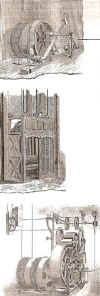 |
Free Library of Philadelphia. Official Catalogue, Dept V, p. 43; McCabe, p. 857. |
| Joseph Goldmark, New York, NY. "Safety elevators for hotels, dwellings, and workhouses, operated by steam, water, or hand power." | . | Official Catalogue, Dept V, p. 42. |
Office Equipment, Supplies
and Services
Purchased by the US Patent Office, 1879
Another view of the equipment, supplies and
services used by US offices in the late 1870s is provided by the following list
from the Annual Report of the Commissioner of Patents for 1879.
| Item | Seller This is generally a distributor, except for purchases directly from manufacturers. |
Amount Paid |
| Blank books | Wm. Ballantyne & Son | $ 19.67 |
| Binders | J. Von Laer | $ 98.60 |
| Binders | H. Van Zuiland | $ 94.90 |
| File boxes | E. W. Woodruff | $ 682.50 |
| Index cards | James S. Oden | $ 37.10 |
| Eyelet machines | James Chapman | $ 14.00 (for two) |
| Eyelet machines | H. L. Lipman | $ 30.30 |
| Typewriters | J. Temple Brown | $ 406.50 |
| Telephones | Gold Stock Tel. Com. | $ 54.17 |
| Telephone | George C. Maynard | $ 53.15 |
| Rental telephones | G. & S. Telegraph | $ 43.75 |
| Coolers | J. W. Boteler & Bro. | $36.70 |

